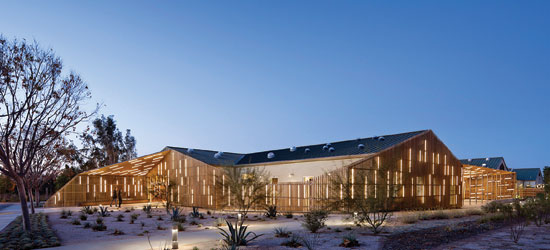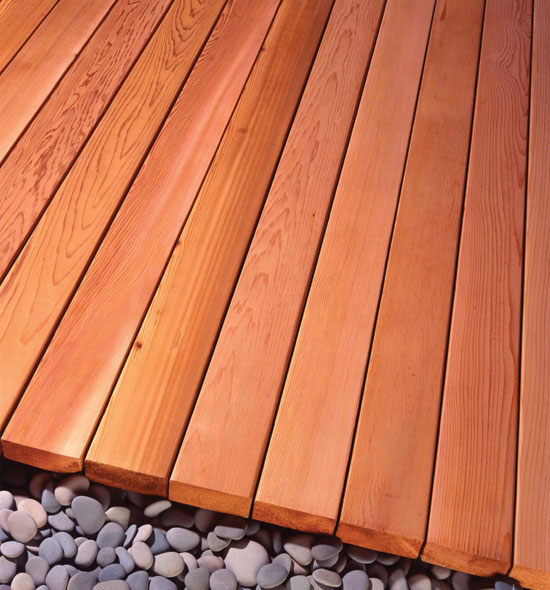Natural Winner: Western Red Cedar and Nonresidential Building
Physical Properties and Image
Where a high degree of control is desired over a building's aesthetic and construction detailing—and over the availability of matching materials—architects and their clients have gravitated toward the consistency and predictability of lumber stocks like western red cedar.
There are other reasons, too, including brand image and institutional identity for some building owners, like the big-box stores now being built that must use the same wood cladding for locations around the world. Western red cedar has also become an emblematic material, carrying connotations of naturalistic luxury. Architectural styles including regional modernism, neotraditionalism, the Pacific Northwest, and mountain lodge styles of the American West are both marked by heavy use of the materials, and these trends have influenced architects elsewhere in the United States but also in Europe, Asia, and Australia.
Practical reasons to use western red cedar are as longstanding as the early U.S. buildings with original western red cedar timbers now more than a century old. They help explain western red cedar's historically heavy use in architecture and construction, too.
Dimensional Stability
Western red cedar is a low-density softwood with high resistance to shrinkage compared to other wood species. It is approximately twice as stable as commonly used softwoods. Western red cedar timbers also provide high relative thermal insulation ability (R-value) as compared with other woods and building materials.
Workability
Like many wood species, western red cedar can be worked with standard tools for cutting, forming, and joinery, according to Edmund A. Allen Lumber Co., which specializes in the species. Standard carpenter glues and joining methods work well with western red cedar, and the species can accept any typical wood finish. Because of its low density and low shrinkage factors—as given by the American Softwood Lumber Standard, PS 20-70—western red cedar tends to lie flat and remain straight longer than other softwoods and some hardwoods. It can be nailed and screwed easily when attached to the structural members of a building using high-quality corrosion-resistant fasteners.
Finish Compatibility
Western red cedar, according to Edmund A. Allen, “though rich in extractives, is free of the pitch and resin found in other softwoods, making it ideal for a wide range of finishes.” This includes lightly toned clear solutions, semi-transparent stains, and two-coat solid colors. The lumber company contends that, “Western red cedar ranks at the top in its ability to accept and maintain a finish.”
Weight and Density
Western red cedar is also one of the lightest commercial softwoods, due to its cellular structure. It averages about 12 percent moisture content and weighs approximately 23 lb. per cubic foot, with a relative density (specific gravity) of 0.32 as compared to yellow pine at 0.42, walnut at 0.65, and oak (0.6 – 0.9)1 Western red cedar's light weight and low density make it easier to handle and more economical to transport than some alternative materials.
 |
Western red cedar is a very stable softwood that is also lightweight and affords a high degree of control if desired over a building’s aesthetic and construction detailing. Photo courtesy of CUC Admin Campus Center, LTL Architects |
Natural Preservative
Western red cedar naturally resists moisture, rot, and damage from termites and other pests due to its thujaplicin content and other inherent attributes of the wood. For this reason, it is ideal for cladding, roofing, fencing, decks, and any architectural applications. Compared with the plastic composites used for decks, boardwalks, and rooftop platforms, cedar is often a comparable choice. “Creating plastic in the first place requires far more energy usage than it takes to harvest a tree,” according to WRCLA. “Plastic also comes from nonrenewable resources, while trees are replanted and grow back. And plastic breaks down very slowly, while timber is biodegradable.”
 |
Western red cedar naturally resists moisture, rot, and damage from termites and other pests due to its thujaplicin content and other inherent attributes of the wood. Photo courtesy of WRCLA |
Fire Safety
Western red cedar exceeds minimum safety classifications for such measures as flame spread and smoke-development ratings, often without any preservatives or added retardant chemicals.
In addition, the track record for cedar around the world demonstrates that the lumber holds its architectural and structural properties extremely well, even after decades of exposure to sun, rain, heat, and cold. This fact was among the top considerations given for its extensive use at Sandy High School, designed by the firm Dull Olson Weekes–IBI Group Architects, which hadn't used the material on its previous nonresidential projects.









